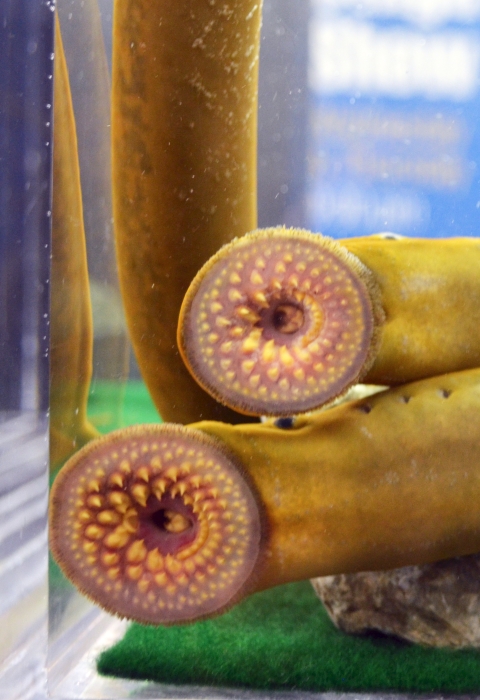Featured Species
Sea lampreys are native to the Atlantic Ocean. In the 1800s sea lampreys entered into the Great Lakes system via manmade locks and shipping canals. Sea lampreys were first observed in Lake Ontario in the 1830s. Niagara Falls served as a natural barrier preventing sea lampreys from entering the other Great Lakes, but modifications to the Welland Canal in the early 1900s provided sea lampreys a path to invade the other lakes. In 1921 sea lampreys were first observed in Lake Erie and quickly spread into Lakes Michigan, Huron and Superior.
Sea lampreys prey on most species of large Great Lakes fish such as lake trout, salmon, lake sturgeon, whitefish, burbot, walleye and catfish. The Great Lakes experienced a drastic decline in lake trout, whitefish and chub populations in the 1940s and 1950s brought on by overfishing, habitat degradation and the invasion of parasitic sea lamprey.
Sea lampreys are naturally anadromous meaning they live in saltwater before migrating to freshwater to spawn. In the Great Lakes, sea lampreys have adapted their life cycle to live entirely in freshwater. Spawning adults deposit eggs in nests in Great Lake tributaries and once the eggs are hatched, the larvae burrow into the sediment where they spend anywhere from 3-7 years filter feeding on detritus, macroinvertebrates and dissolved organic material. After reaching sufficient size, larvae undergo a metamorphosis, growing eyes and an oral disk containing razor sharp teeth and a digestive system capable of feeding on fish blood and absorbing nutrients for growth. The newly transformed lamprey migrate downstream, heading for one of the Great Lakes in search of a host. Once in the lake, they will spend 12-18 months parasitizing fish and feeding on their blood and body fluids. In that short amount of time, each parasitic lamprey is capable of destroying 40 pounds of fish. Sea lampreys prey on all large Great Lakes fish species including lake trout, salmon, rainbow trout, whitefish, walleye and catfish. At the end of their parasitic phase, they undergo another, less drastic transformation in preparation to spawn and head back upstream where they die after spawning.
